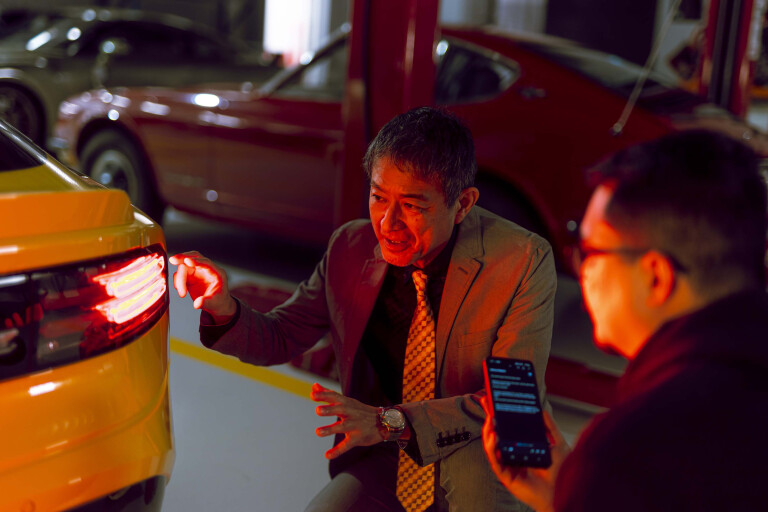
Few execs in the car world are like Hiroshi Tamura. I’m watching the 60 year-old Nissan veteran crouch next to the new Z, hands on the ground, mimicking a sprinter in the starting blocks – a sprinter in a crisp grey suit and driving shoes. With a yell he leaps up and forward like a spring, channeling the energy of a full-bore launch-control start. He does all this just to tell me about a swage line in the sheetmetal.
Nissan’s new Z? To be honest, it’s more like Tamura’s new Z. The man has lived and breathed Nissan performance cars for decades, catching the bug long before he became a Nissan lifer back in ’84, and for Tamura the box-fresh turbo Z represents the culmination of his career.
His heart and soul – both of which he wears on his sleeves – have been poured into it, and he’s fiercely, justifiably proud of the final result.
But it almost didn’t happen.

The business case for sports cars is tenuous at the best of times. However in 2019, a year after Nissan’s design chief Alfonso Albaisa let slip to Wheels that a new Z was already in the works, Nissan began a protracted financial slump that led to its biggest yearly loss ever.
“Now I can be confident, but imagine for three years before [now], everything was nervous about the project, it was floating, suspended,” Tamura explained, now sitting in the driver’s seat of a yellow Z Proto.
“The future was not so easy to see, I was always nervous that suddenly, they would kill this project. There was a risk of this, so many times.”

For Tamura, terminating the Z would have robbed him of one last project.
Now approaching retirement age and with the Z’s development done and dusted, Tamura has hung up his spurs as a Chief Product Specialist and has settled into a more relaxed role as a brand ambassador – though the launch schedule for the Z has seen him boarding jets with an unenviable frequency for much of 2022.
In the end Nissan endured its financial trouble and, to its credit, kept the lights on in its sports car development division. Tamura, now able to see the fruit of his labour in the hands of the public, seems relieved. It’s been the end result of five years of hard work for him and his team, and the task of bringing a Z to market in a cost-effective fashion is no easy feat – even without economic headwinds.
It all started on March 1 2017 with a hand-written note, where Tamura sketched out what was needed to take Nissan’s iconic sportscar to a level well beyond the 370Z.

“That note was for the R&D boss, [Kinichi] Tanuma,” Tamura said.
“Tanuma was charged with being the GT-R chief vehicle engineer, so he was one of our team. So he was easy to access, for me to say ‘Tanuma-san, give me your time, just 15 minutes’. So I wrote about my idea very quickly to summarise it for him – let’s make a Z! That was the message”
“What kind of Z, was Tanuma’s question to me. The answer was more about maintaining loyalty to our customers. Normally people love to talk about new, new, new, but for [Z]… how can I say… it’s about blending some feeling for the nostalgic with something new.”
And to help guide the new Z’s development team with imbuing the car with the requisite amount of nostalgic ‘Z-ness’, Tamura looked to the past.

“People love to talk about the first generation Z and of course I respect the S30, the second generation Z, and even the first V6: the Z31. Then in 1989 we had a big jump, which was the Z32.”
The Z32 300ZX, besides taking the Z’s design language away from the big shoulder pads and punch-perm 1980s styling of the Z31, also offered an extremely diverse line-up with two wheelbases, the choice of a two-seat or two-plus-two layout, removable glass targa roof panels for both of those body styles, a fixed all-steel roof option for the two seater, a naturally-aspirated engine and the headline-grabbing twin-turbo V6.
Not to mention the option of a five-speed manual or four-speed auto, plus a soft-top convertible for those who found the targa roof didn’t let enough photons onto their dome.
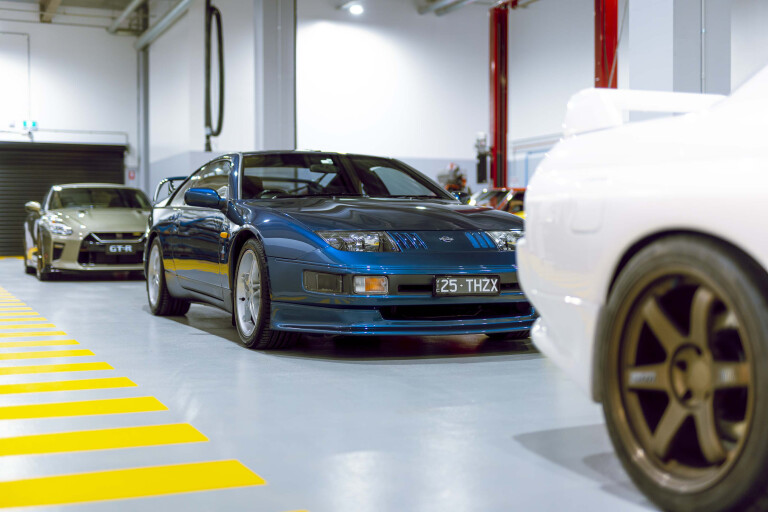
You can see the Z32’s influence in the LED light tubes of the new Z’s tail lights, but asked whether customers wanted a return of the two-plus-two body style, targa tops or even a lower-output base model engine, Tamura said that today’s sports car buyer doesn’t seek that level of diversity anymore.
“From customer voices recently, a sports car must have a compact core, be lightweight,” he said. They did, however, want something else from the Z32 besides its cyberpunk tail lights: a twin-turbo V6.
While there’s boundless enthusiasm for the Z within Nissan’s halls, economic realities were the leash that kept the project from running into the Armco.
Tamura joined Nissan in 1984 as a salesperson before entering product planning two years later, landing him at one of Japan’s biggest automakers at a time of unprecedented economic prosperity – Japan’s infamous bubble economy.

Financial capital was easy to access with the Japanese government encouraging businesses to spend freely, and spend they did: these are the economic conditions that spawned the aforementioned Z32 300ZX and its dizzying menu of variants, along with the R32 GT-R, Silvia and Leopard – all two-door performance cars, a format not known for intensive profitability.
The economy’s a little different these days.
A shoestring development budget necessitated some savvy recycling for the new Z. The platform is the same fundamental floorpan as the 370Z, but with new exterior panels and structural reinforcements around the engine bay, rear floor and hatch opening that grant it a new aesthetic and a 10.8-percent increase in torsional stiffness.
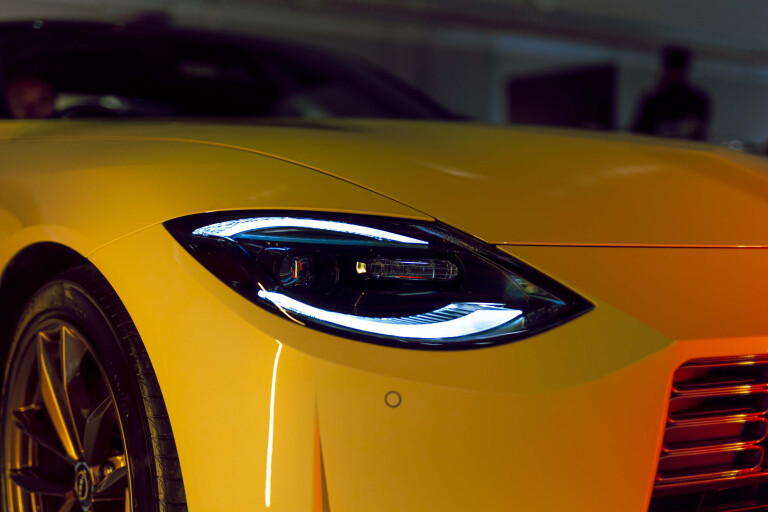
Suspension subframes are the same, but with new geometry affording more caster angle for stronger steering feel and high-speed stability, while the dampers ditch the 370Z’s twin-tube construction in favour of more responsive monotubes.
“Nürburgring times, maximum speed; those individual things are one-dimensional”
There’s some obvious carryover in the interior, with door handles, air vents and indicator/wiper stalks all looking very familiar, but the new dash, vastly improved steering wheel and all-electronic instrument panel (it was actually cheaper to use this display rather than engineering a new set of analogue clocks) modernising the cockpit.
And then there are the greasy bits.
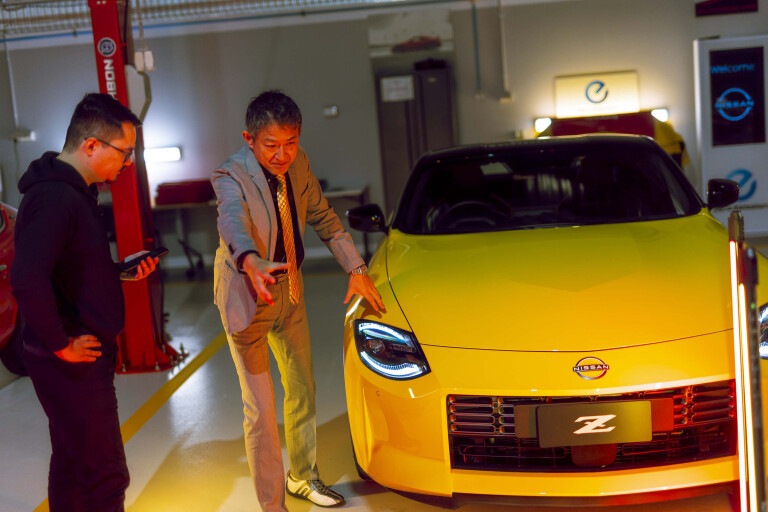
“The engine I could not make from new, of course,” says Tamura. “The motor is from the [Skyline] 400R, or Infiniti Q50 – it’s the same twin-turbo system. But it now has a ‘Dance Partner’ attitude because we added more response, and we did that with the recirculation valve, which was something of an R32 Skyline idea, with the twin valves.”
Those recirc valves make the Z’s version of the VR30DDTT engine unique. Though the peak power and torque outputs of 298kW and 475Nm are the same as the Q50 Red Sport, the Z’s engine keeps its dual compressors spinning faster between lifts of the throttle thanks to the increased flow of its recirculation system, which gets them back on boost quicker when the accelerator pedal is reapplied.
The torque band is wider, too – while the Q50 made max twist at 5200rpm, the Z delivers that number all the way from 1600rpm through to 5600rpm.

It’s a similar story with the nine-speed automatic, which replaces the 370Z’s seven-speeder.
“Again, 100 per cent brand-new is so tough to get, that’s why we got the nine-speed from the Titan heavy-duty truck.”
“Not only the number of gears is improved, but the gear-to-coverage zone. Each gear can cover a more narrow section [of the rev range] – up or down, third-to-fourth, fourth-to-fifth, even back from fifth to first. It’s easier to do that because there are so many gears to cover the same range. That’s the benefit of the nine-speed.”
But why not just recycle the old seven-speed if constraining cost was so vital, rather than using the more sophisticated nine-speed unit from JATCO?
“The seven-speed was sporty…” he pauses, “…but it wasn’t good enough for the ‘Dance Partner’ level of super-synchronised response that we wanted.”
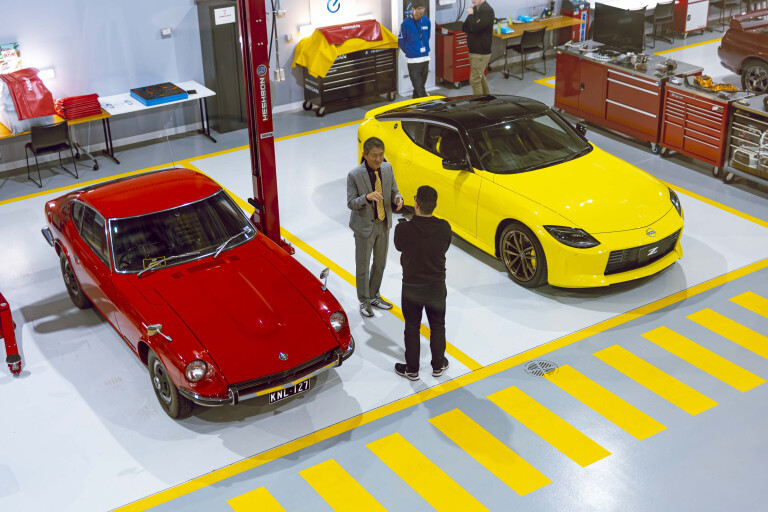
“The powertrain is very expensive; that’s why we are charging more for it. For example, in the USA we charge $10,000 more for the base model [compared to the 370Z], apples-to-apples. For this twin-turbo with a nine-speed, both those things – and the mechanical clutch LSD – are the main reasons for this price increase.”
There are other mechanical changes. Ensuring a manual transmission stayed in the mix was important enough for Tamura to hoodwink his bosses about manual uptake, using the Nismo (in minuscule print) version of the 370Z’s manual/auto split as evidence that people were still buying three-pedal cars.
Had he used the regular 370Z’s stats, we probably wouldn’t have a stick-shift in the new car, and while it’s still fundamentally the same unit as the 370Z, it’s been revised with a reworked shifter for a sportier and less notchy gate, while the final-drive ratio is taller.
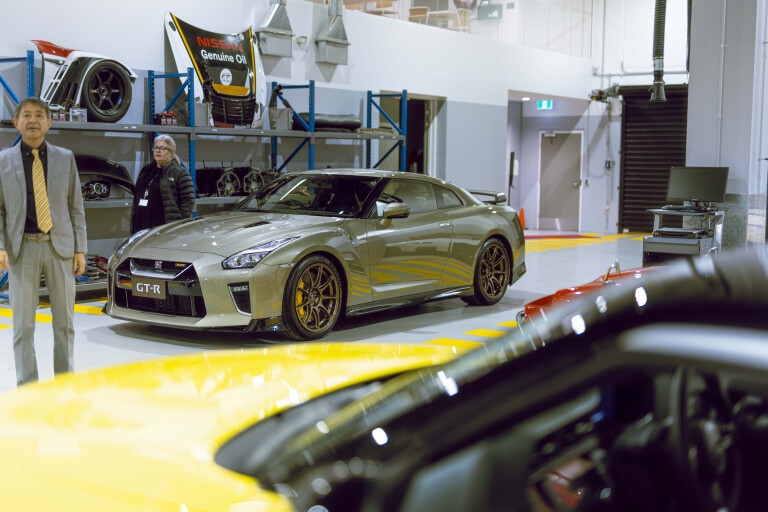
Brake feel is also enhanced. The four-piston front and two-piston rear Akebono calipers and rotors carry over, but with new pad compounds and brake booster sizing to give a more GT-R-like feel to the pedal. The steering is all-new, however, bearing no resemblance to the steer-by-wire system used in the Q50 and Skyline that also used this engine.
That system has been binned in favour of a proper mechanically linked electric power steering system. For Tamura, the sum of all of these parts has to be a car that engages its driver in more than one way.
“People always love to talk about zero to 100km/h times, or Nürburgring times or maximum speed, or horsepower – but those individual things are one-dimensional; a single dot. However we are living in three dimensions; this car is a product of three-dimensional thinking.”
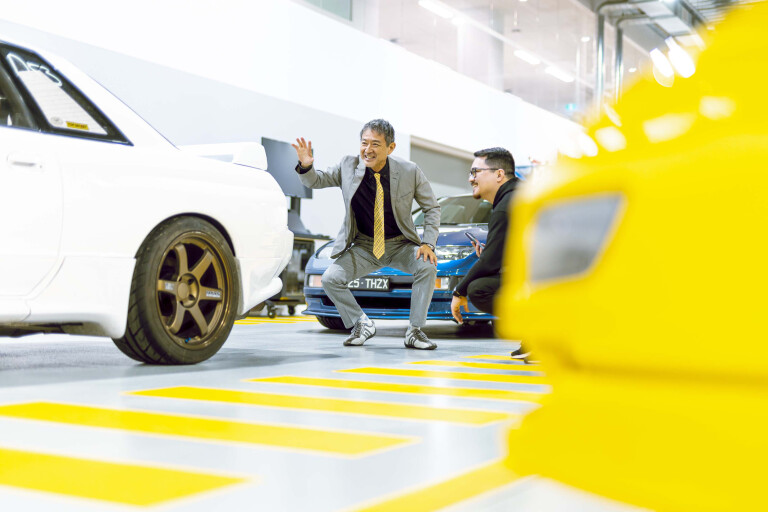
By the same token, the retro throwbacks like the headlamps, rectangular grille and tail lights can’t be one-dimensional either – they must still satisfy core sports car functions.
The grille, for example, hides a crash structure in the centre that’s a modern necessity, but the aperture is shaped to provide as much air as possible to the Z’s cooling package – which, with five separate heat exchangers and a radar unit in front of them all, is considerably more complex and demanding than the 370Z’s, which had just a radiator and an air conditioning condenser to accommodate.
At the back end, the ducktail spoiler isn’t just a visual link to the 240ZG that Tamura owned as his second car, it’s a lift-reducing aerodynamic aid that cleans up the airflow behind the new Z. It also works in conjunction with the squared-off bodywork of the Z’s tail lights.
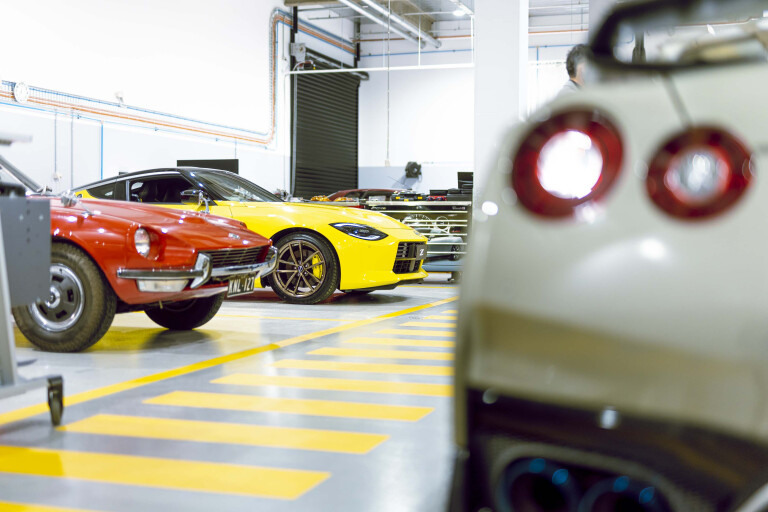
Tamura hops over to a nearby R35 GT-R T-Spec (another of his babies) to point out the abruptly chamfered perimeter of that car’s rear end, which performs a similar drag-reducing function.
Rubbing his chin, Tamura says that if he had his way the whole of the Z’s rear would have been like that, but alas the gentle taper from the rear wheel wells to the tail lights was a design necessity rather than an aerodynamic one.
But he’s content not to have his way on everything. The new Z very much bears Tamura’s stamp, but it was created first and foremost to serve the demands of Nissan’s Z-worshipping zealots.
The Z serves as a fulfilling full-stop to his product planning career, and while his days of product planning are over, he’s recently acquired a classic C110 ‘Kenmeri’ Skyline to fiddle with – the same model as his first car. Tamura’s pursuit of retro authenticity is clearly not confined to business hours.
Skyline’s not the limit
Hiroshi Tamura's road cars
Hiroshi Tamura’s resume might have things like the R33 Skyline GT-R, R34 Skyline GT-R, R35 GT-R, 370Z Nismo and, now, the new Z on it, but the cars that have passed through his garage give a better insight into his mind.
His first car was a C110 Nissan Skyline coupe, the famed ‘Kenmeri’, which he followed up with a 240ZG, then a turbo Z31 300ZX, then a highly-modified R32 Skyline GT-R – which he still has today.
An engineer by training, Tamura was never the type to keep his cars factory-standard – they were all modified in some way, and that experience – whether botching the cooling performance of his 240ZG or realising that his 800hp R32 was actually much better with ‘just’ 600hp – informed the creation of the new Z.
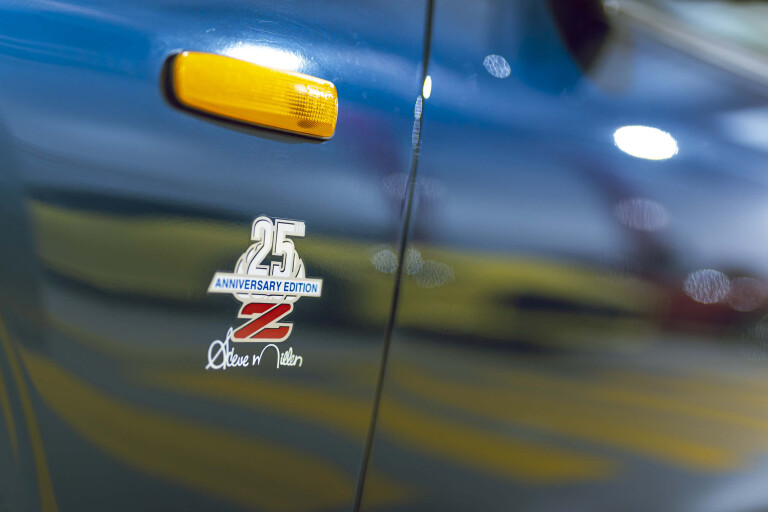

COMMENTS